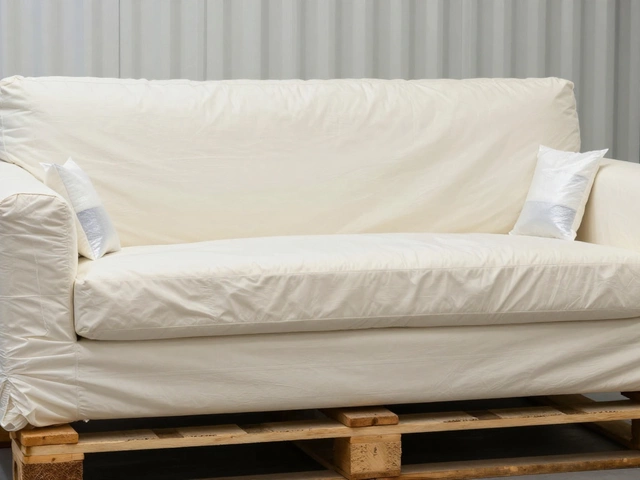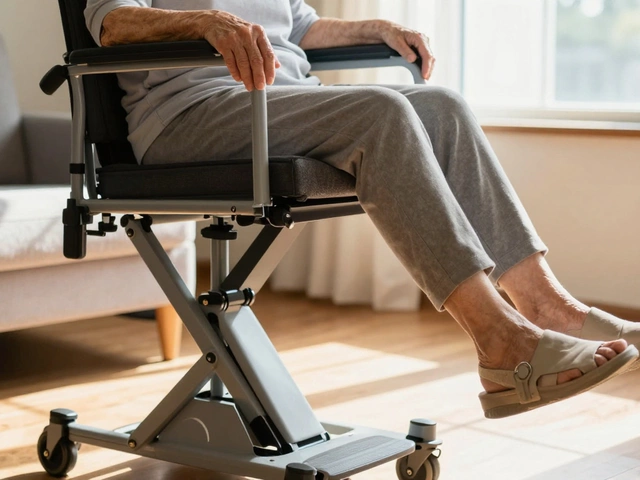So, you’re wondering if Medicare is going to help pay for that fancy Lazy Boy lift chair you’ve had your eye on. Here’s the thing: the rules aren’t as straightforward as most folks hope. Medicare will consider helping, but it doesn't just write a check for the whole chair. In fact, it usually only helps with one specific part—the electrical lift mechanism inside the chair—because that's what actually helps you get up and out safely. The rest, like those buttery-soft armrests and plush cushions, are on you.
If you’ve ever tried to help someone—or if you’ve watched your own golden retriever Max jump up effortlessly while you struggle to follow—you know how valuable a lift chair can be. Don’t just take the first salesperson’s word, though. There are rules, paperwork, and frankly, a lot of waiting. The best thing? Know exactly what you’re getting into before you shop or file a claim.
Medicare calls these chairs “patient lift mechanisms.” The process can be a bit of a hassle, but if you’re prepared, you’ll avoid a bunch of headaches. Let’s break down what you really need to know and what steps will get your claim moving without pointless runaround.
- How Does Medicare Work With Lift Chairs?
- Which Parts of a Lazy Boy Lift Chair Are Covered?
- What You’ll Need to Qualify
- Pitfalls and Common Mistakes
- Smart Buying Tips for Your Next Lift Chair
- Other Ways to Save on Lift Chairs
How Does Medicare Work With Lift Chairs?
Medicare won’t pay for your entire Lazy Boy lift chair, but it may chip in for a key part: the motorized lifting mechanism. That’s because Medicare sees the lifting device as a medical necessity for folks who have trouble standing up or sitting down, but a regular recliner doesn’t count. The program responsible here is Medicare Part B, which handles things like doctor visits and durable medical equipment (DME).
Here’s how it typically works:
- You need a doctor to say, in writing, that the lift chair is medically necessary—usually because standing up from a regular chair is just too tough due to a medical condition like severe arthritis or neuromuscular disease.
- The supplier you get the chair from must be enrolled with Medicare. If they aren’t, you’re out of luck for coverage—no matter how nice the chair is.
- Once approved, Medicare will only help cover the lifting device—usually up to 80% of the Medicare-approved amount—while you have to pay for the rest of the chair and whatever Medicare doesn’t cover. The cost of the comfy upholstery, fancy buttons, and recliner features fall on you.
To make this even clearer, here’s a simple breakdown of what Medicare does and doesn’t cover:
| Lift Chair Part | Medicare Coverage |
|---|---|
| Motorized Lift Mechanism | Yes, up to 80% |
| Chair Frame & Upholstery | No |
| Delivery/Setup | No |
Don’t forget: you’re on the hook for your annual deductible, and you’ll owe the usual 20% coinsurance after that. Sometimes, this still leaves a lot to pay out of pocket—especially if you want all the bells and whistles that come with a premium Lazy Boy lift chair.
So, to actually tap Medicare for help, you need the right paperwork and a supplier who knows the ropes. Skip either step and your claim will hit a wall, fast.
Which Parts of a Lazy Boy Lift Chair Are Covered?
If you’re banking on Medicare to pick up the full tab for a Lazy Boy lift chair, here’s the bottom line: only the lift mechanism is eligible for coverage. That means Medicare won’t pay for the actual recliner frame, the comfy cushions, fancy fabrics, heating options, or cup holders. They only see the electrical part that helps you stand as "medically necessary." Everything else is on your wallet.
To break it down even further, you can think of the chair as having the following components:
- Lift Mechanism (Covered) – This is the motorized part inside the chair that gently moves you from sitting to standing and back. Medicare considers this durable medical equipment (DME) and may cover 80% of its approved cost, but only after you hit your Part B deductible.
- Chair Frame & Padding (Not Covered) – The stuff that actually makes your Lazy Boy a Lazy Boy—frame, upholstery, padding, and extras—doesn’t count in Medicare’s world. They call this "furniture," not medical equipment.
- Power Controls & Accessories (Not Covered) – This means remotes, massage, extra motors and other add-ons or upgrades are paid out of pocket.
Medicare pays suppliers based on their fee schedule, so you might want to check actual numbers before you shop. Here’s a quick snapshot of what you might see:
| Part | Typically Covered by Medicare? | Average Out-of-Pocket Cost* |
|---|---|---|
| Lift Mechanism | Yes (80% after deductible) | $300 - $500 |
| Chair Frame & Fabric | No | $400 - $1,200+ |
| Massage/Heat/Add-ons | No | $100 - $600 |
*Price ranges based on 2024-2025 retail estimates from major recliner suppliers.
When shopping, make sure the supplier actually separates out the lift mechanism cost on your receipt. That's the only way you're going to get reimbursed, since Medicare wants to see that split out. If the supplier can't—or won't—do that, you’re probably better off looking elsewhere.
What You’ll Need to Qualify
If you want Medicare to help pay for your Lazy Boy lift chair, you’ve got to meet a few key requirements. First off, you have to be enrolled in Medicare Part B because Part B covers durable medical equipment (DME)—that’s the category lift chair mechanisms fall under. Not every chair qualifies; it has to be medically necessary for you to get around at home.
Let’s talk paperwork. You’ll need a prescription or a written order from your doctor. Doctors can’t just say you want a comfy chair; they’ll have to prove you actually need help standing up due to limited mobility—the kind that actually makes leaving a regular chair tough or unsafe.
Here’s what Medicare usually wants:
- Your doctor’s written order, specifying that a lift chair is medically necessary because you have severe arthritis of the hip or knee or a serious neuromuscular disease.
- Proof that you’re unable to stand up independently from a regular chair.
- Evidence that other ways of treating your condition (medicine, physical therapy) didn’t work or aren’t an option for you.
- A supplier who is enrolled in Medicare (and accepts Medicare assignment, so you aren’t hit with surprise costs).
Medicare almost never covers these chairs if you’re in a hospital or skilled nursing facility, or already have another type of recliner that serves the same purpose. Also, they’ll want to make sure that you can operate the chair by yourself once it’s in your home.
| Requirement | Details |
|---|---|
| Medicare Part B Enrollment | Must be valid and active |
| Medical Necessity | Severe arthritis or neuromuscular disease |
| Doctor’s Written Order | Must specify medical need for lift |
| Tried Other Treatments | Must show limited/no results |
| Supplier | Medicare-enrolled and assignment-accepting |
| Mobility Limitation | Can’t stand from regular chair without help |
If you skip even one of these boxes, your claim can get denied. Double-check everything before you order. Save all your paperwork—Medicare can ask for details later, and missing documents can stall your reimbursement for months. This isn’t just red tape; it’s how you make sure you actually get some help covering the cost.

Pitfalls and Common Mistakes
If you’re counting on Medicare to help with a lift chair, there are a few snags people hit over and over. Back when my dad wanted one of these things, things got messy mostly because of simple paperwork issues—yep, it’s really that basic sometimes.
The biggest mistake is thinking Medicare pays for the whole chair. Sorry, but they only help with the lift mechanism—the motorized part that raises and lowers you. The comfy cushioning, the slick upholstery, and the massager? That’s all up to you. If you buy a whole chair and expect a full reimbursement, you’ll be disappointed.
- Lazy Boy lift chair dealers aren’t always up front about this. They might hint Medicare will cover way more than it actually does.
- People forget you need a doctor’s prescription and a special form (called a Certificate of Medical Necessity). Without that, your claim won’t even get considered.
- Not all suppliers participate in Medicare. If you buy from a random furniture shop instead of a Medicare-approved supplier, you probably won’t get a cent back.
There’s another trap: timing. Medicare won’t backdate a claim if you buy your lift chair before you’ve got all your paperwork together and approved. So don’t think you can get approval after you’ve already bought the chair. It just doesn’t work that way.
Here’s a quick table to hammer home the big common mistakes and how to avoid them:
| Mistake | Why It’s a Problem | Fix |
|---|---|---|
| Buying any chair, not a lift chair with a certified mechanism | Medicare only pays for the lift mechanism in approved chairs | Buy from a Medicare-participating supplier |
| No doctor’s prescription or Certificate of Medical Necessity | Claim gets denied | Visit your doctor first, get the right paperwork |
| Assuming full chair is covered | You only get partial reimbursement | Budget for the non-covered pieces |
| Wrong supplier (not Medicare approved) | No Medicare payment at all | Check supplier status before purchasing |
| Buying before approval | Medicare won’t pay retroactively | Get approval confirmation before buying |
One last thing: Medicare has limits on how often they’ll help pay for major equipment like this. Usually, you can only get coverage for a lift mechanism once every five years (unless your health situation dramatically changes). Don’t waste your shot by missing a step in the process.
Smart Buying Tips for Your Next Lift Chair
Shopping for a new lift chair can be a game-changer, but only if you pick the one that actually fits your needs (and your living room). Here’s how to make sure you end up with a chair you’ll love, without busting your budget.
- Lazy Boy lift chair buyers should make sure the chair’s height and width match your size. A chair that’s too big or too small won’t give you the support or comfort you need. Take your measurements or, even better, try sitting in a couple at the store if you can.
- Pay close attention to the lift mechanism. Not all lift chairs are created equal. Some use single-motor mechanisms (where the back and footrest move together), while pricier models let you control each part separately. The extra control is a must if you spend hours in the chair or have specific mobility needs.
- Medicare will only consider covering the motorized mechanism. The fancy features—heat, massage, cup holders, memory seats—are on your dime. Make a list of must-haves vs. nice-to-haves so you know where you can compromise.
- If you’re choosing between fabric and leather, remember that leather may be easier to clean but also gets hot. Fabrics offer more breathability, which matters if you live in a warm area or have pets that shed (looking at you, Max!).
- Check the warranty. Chairs are an investment, and the lift mechanism is what usually needs repair. Leading brands like La-Z-Boy usually offer about 1 year for labor, and up to 3-5 years for the mechanism itself.
Ever wonder what features people actually use or regret? Check out this quick stat table based on actual user reviews from leading mobility forums:
| Lift Chair Feature | Percent of Owners Who Use Frequently | Percent Who Wish They Skipped It |
|---|---|---|
| Power Recline/Lift | 94% | 1% |
| Massage Function | 38% | 31% |
| Heated Seat | 29% | 18% |
| Memory Settings | 21% | 14% |
| Cup Holder | 17% | 25% |
One more thing: most Medicare-approved suppliers will help with paperwork if you tell them upfront that you plan to file for reimbursement. They’ve dealt with these claims hundreds of times — don’t be afraid to ask for help. And for peace of mind, check the return policy before swiping your card. Some stores will let you try the chair at home for a couple of weeks, but restocking fees can be nasty if you change your mind.
Bottom line—know what you need, stick to a plan, and don’t get swept away by unnecessary extras. Smart shopping means a happy back (and if you’re lucky, a happy wallet, too).
Other Ways to Save on Lift Chairs
If you've checked your Medicare benefits and the math still leaves you wincing, you're not alone. A brand-new Lazy Boy lift chair can cost anywhere from $700 to over $2,000, and Medicare usually covers only the lift mechanism, which is just a fraction of that price tag. Luckily, a few smart moves can take the sting out of those costs.
- Shop for Sales and Floor Models: Big furniture stores are famous for discounting floor models or running sales around holiday weekends. Some folks save over 30% this way—worth asking about even if you have to deal with a small scratch or two.
- Look for Local Grants and Nonprofits: Some organizations, like the Lions Clubs or the Mobility Equipment Recyclers of America, have programs to help seniors or people with disabilities pay for mobility equipment, including lift chairs. You’ll need to check your local chapter or website to apply.
- Try Gently Used Options: Websites like Craigslist, Facebook Marketplace, and even local medical supply resellers often list lightly used lift chairs for half the new price, sometimes even less. Just check the lift mechanism works before handing over cash.
- Ask About Store Financing or Payment Plans: Some Lazy Boy dealers and furniture stores offer zero-interest payment plans. It spreads the cost out over a year or more, making a big spend easier to handle.
Medicaid, some state-run health programs, or VA benefits might help more than Medicare if you meet certain criteria. Requirements and coverage vary by location, but it’s always worth a call. You can also ask your doctor or physical therapist if they know of community programs—sometimes clinics keep lists of resources for folks who ask.
"Never assume the sticker price is what you pay—most customers qualify for some type of discount, especially if they ask about senior or medical programs," says Kevin Kelly, director at Mobility Equipment Resource Center (2023).
To give you a sense of how much you might save, here's a quick table breaking down potential price points:
| Option | Average Price | Potential Savings vs. New |
|---|---|---|
| New Lift Chair (Retail) | $1,200 | — |
| Medicare Coverage (Lift Mechanism Only) | $400 reimbursed | Up to $400 |
| Used Lift Chair | $600 | $600 |
| Floor Model or Sale | $800 | $400 |
| Local Grant Program | Varies (sometimes free or steep discount) | $600 or more |
Don't be shy about calling around. Sometimes the best deals won't even be advertised. The squeaky wheel gets the grease, and that's extra cash in your pocket—maybe even enough to treat Max to some new dog toys, too.







